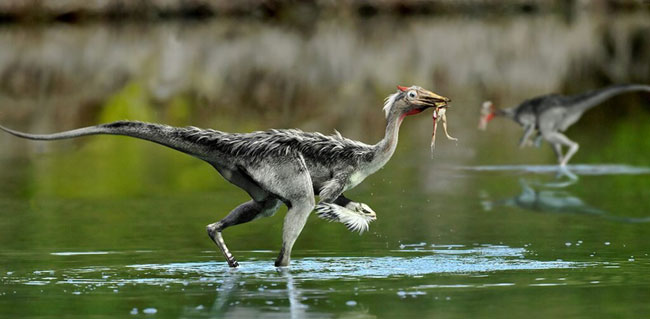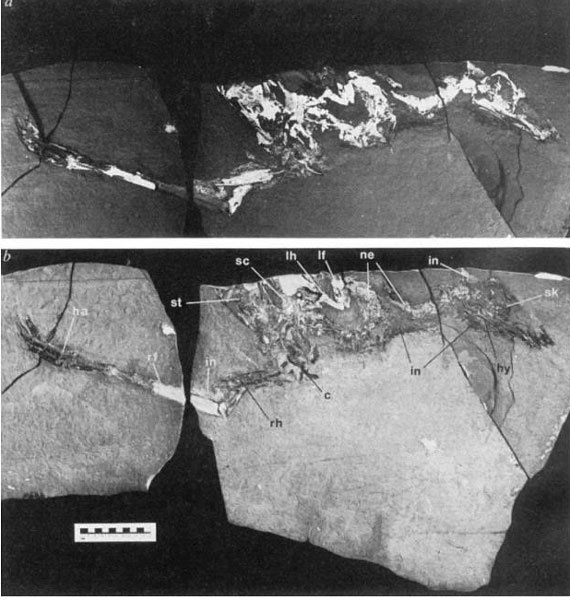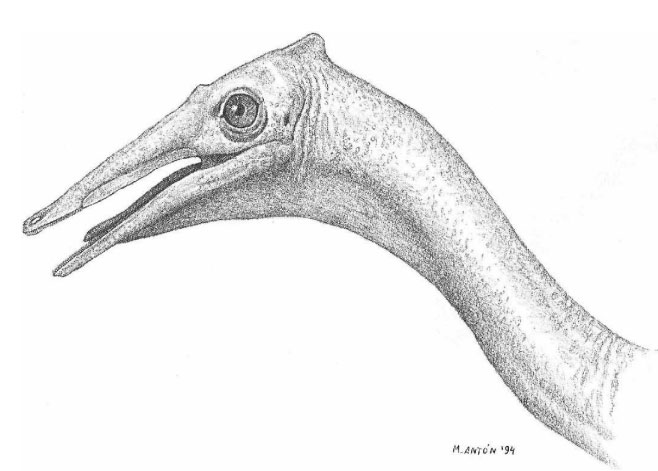Pelecanimimus Under the Spotlight
Known from a single specimen discovered in Spain back in 1993 Pelecanimimus (P. polyodon) from the Las Hoyas lagerstätte was the first unambiguous ornithomimosaur described from Europe. Although the scientific paper erecting the genus was published in 1994, no detailed examination of the holotype fossil material (LH 7777) had been undertaken.
A re-examination of the holotype fossil has been carried out by a team of international scientists, which included Francisco Ortega, one of the authors of the original scientific paper describing this 2-metre-long theropod. They conclude that Pelecanimimus was remarkably bird-like although as a member of the Ornithomimosauria it was not that closely related to the dinosaur lineage that led to the evolution of the birds.

An Ossified Sternum
Pelecanimimus when it was named, was the only ornithomimosaur that had a preserved ossified sternum. The sternum is not usually preserved in theropods, it has been suggested that this part of the skeleton was not ossified and therefore it did not fossilise well, or perhaps the absence of this structure was due to preservational bias. The distance observed between the coracoids in articulated theropod specimens led to many palaeontologists inferring its presence. In this new paper, the researchers examined the shape of the sternum and concluded that its morphology was similar to the sternums of dinosaurs more closely related to birds such as Velociraptor and Oviraptor (the Maniraptora clade).

Pelecanimimus Breathed Like a Bird
Furthermore, the research team found evidence of the presence of uncinate processes. These small, hook-shaped bones are linked to the ribs and are also present in extant and extinct birds. Pelecanimimus is the only known representative of the Ornithomimosauria with these structures and this is the first time that uncinate processes have been found in a non-maniraptoran theropod. If maniraptorans evolved these structures, along with the distantly related Pelecanimimus, this suggests convergent evolution.
In birds, uncinate processes function to increase the mechanical advantage for movements of the ribs and sternum during respiration. They make breathing more efficient. In summary, the research team suggest Pelecanimimus, breathed like a modern bird.
Elena Cuesta, the lead author of the study from the Fukui Prefectural University, Japan explained:
“The fact that Pelecanimimus preserved these processes suggests that it also had a bird-like breathing mechanism. Apparently, the origin of such avian-like features is older and more widespread than thought. However, the evolutionary history of both the ossified sternum and uncinate processes is still unclear. Nevertheless, their detection in Pelecanimimus confirms that these elements were present in Ornithomimosauria as well as in other dinosaurs.”

Distinctive Features on the Hands
The joint Japanese/Spanish research team also discovered distinctive features on the hands. The manus of Pelecanimimus has conspicuously elongated metacarpals, particularly metacarpal I and lengthened distal phalanges, a feature also found in some later, more derived ornithomimosaur species. The authors of the study conclude that these anatomical features require the erection of a new clade, the Macrocheiriformes. This clade is defined as including Pelecanimimus and more derived ornithomimosaurs. The term Macrocheiriformes, means “forms with large hands.”
The scientific paper: “Pelecanimimus (Theropoda: Ornithomimosauria) postcranial anatomy and the evolution of the specialized manus in Ornithomimosaurs and sternum in maniraptoriforms” by Elena Cuesta, Daniel Vidal, Francisco Ortega, Masateru Shibata and José L Sanz published in the Zoological Journal of the Linnean Society.

